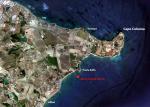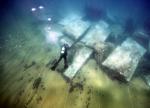Summary (English)
The wreck lies in the bay of Scifo, just south of the promontory of Capo Colonna (ancient Lacinium promontoriu, site of the sanctuary dedicated to Hera). It lies on the seabed at a depth of 6.5 m and 160 m from the promontory of Capo Pellegrino, known locally as Punta Scifo. Discovered by Luigi Canfora in 1986, the wreck was investigated in 1987 by the Cooperativa Aquarius, directed by Alice Freschi, on behalf of the Archaeological Superintendency of Calabria. These investigations, including excavation and planning, remained largely unpublished. The site has been newly investigated using new technology and cataloguing has begun of the moveable finds (metal and ceramics) recovered during the 1987 campaign and largely forming part of the ship’s equipment.
The archaeological deposit “Punta Scifo D” comprises over 50 marble artefacts belonging to the cargo of a stone transporting ship which, a preliminary study of the pottery and amphorae dates to the 3rd century A.D. The marbles, in the form of blocks and slabs, are all in the rough-hewn stage and some are very large weighing over 20 tons. Mineral-petrological and isotope analyses undertaken by Lorenzo Lazzarini, I.U.A.V (Venice) on a series of samples, indicate that this is proconnesian marble quarried at the site of Saraylar on the Turkish island of Marmara.
During the 2011 investigation, a photo-mosaic was made of the entire area where the stone elements lie and all of them were re-measured in order to determine the volume and weight of the cargo on the ship. The first results suggest that the “Punta Scifo D” ship transported one of the largest ancient stone cargoes discovered in the Mediterranean. Study and processing of the data is underway and this should make it possible to determine the original positions in stowage of the stone blocks and to understand what the maximum dimensions and hydrostatic characteristics of the ship were. The few preserved timber remains from the hull showed the use of a double layer mortice and tenon construction technique. Like the marble’s provenance, some of the ships equipment (pottery and amphorae) was linked to productions in the Aegean-microasiatic and Pontine areas.
Investigations were renewed in 2013 and study of the data and materials is ongoing.
- Domenico Marino - Soprintendenza Beni Archeologici della Calabria
- Carlo Beltrame - Università Ca' Foscari Venezia, Dipartimento di Studi Umanistici
- Salvatore Medaglia - Università della Calabria
Director
Team
Research Body
- Soprintendenza per i Beni Archeologici della Calabria
Funding Body
- Associazione Reitia onlus
- Università Ca' Foscari di Venezia






![Download [PDF]](/excavation/skins/fasti/images/results/download_sml.png)
